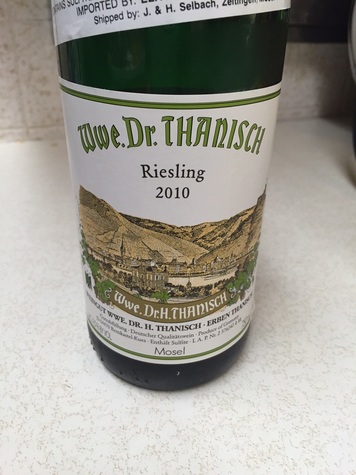I will admit up front that I have had a recent love affair with Riesling. Although we have plenty of Riesling in the United States (and here in Michigan) I'm currently having fun exploring German styles.
German wines are a miracle if only because they are planted so far north. At 51 degrees north, they're as far north as you can go and still ripen wine grapes. To give perspective, that's about the latitude of southern Hudson Bay in Canada.
For the first time, I'll focus on a specific wine. The Wwe. Dr. Thanisch Riesling from the 2010 vintage. This remains one of my favorite Rieslings of all time, and it was only $21! The site that the grapes are grown is ideal for Germany; a 70% slope that maximizes the time in the sun - an important factor in a cool climate. Some very well-noted vineyards are within a stones's throw (literally) and the similar location means that trading down in a good vintage like 2010 means quality can be found at lower price points.
Upon pouring the wine, it has a light sparkle that quickly dissipates. The aroma of a mature Riesling pours out of the glass and into the air around it. On the nose, baked apricot, lemon curd, wet slate and the slight petrol nose of an aging Riesling are present. This petrol like nose is a distinguishing feature of mature German Riesling, but for me, the uniqueness is what makes it so interesting. On the palate, the apricot flavors are a bit more fresh, as is the lemon. The unique minerality of the slate-covered hill comes through at the finish and hangs out with the crisp acidity for a long finish. The wine's sweetness and balanced acidity would probably allow it to stand up to most holiday meals - perhaps that Christmas ham? Overall, I'm rating this bottle a 9.5 for the price.
Should you not be able to get this exact bottle (I found it at Vine & Brew, and it's distributed by Imperial Beverage in Michigan), safe bets for German Riesling would be the 2008, 2009, 2010 and 2011 vintages.
Later in the month I'll have a comparison of German Rieslings and attempt to explain some of the classifications.
German wines are a miracle if only because they are planted so far north. At 51 degrees north, they're as far north as you can go and still ripen wine grapes. To give perspective, that's about the latitude of southern Hudson Bay in Canada.
For the first time, I'll focus on a specific wine. The Wwe. Dr. Thanisch Riesling from the 2010 vintage. This remains one of my favorite Rieslings of all time, and it was only $21! The site that the grapes are grown is ideal for Germany; a 70% slope that maximizes the time in the sun - an important factor in a cool climate. Some very well-noted vineyards are within a stones's throw (literally) and the similar location means that trading down in a good vintage like 2010 means quality can be found at lower price points.
Upon pouring the wine, it has a light sparkle that quickly dissipates. The aroma of a mature Riesling pours out of the glass and into the air around it. On the nose, baked apricot, lemon curd, wet slate and the slight petrol nose of an aging Riesling are present. This petrol like nose is a distinguishing feature of mature German Riesling, but for me, the uniqueness is what makes it so interesting. On the palate, the apricot flavors are a bit more fresh, as is the lemon. The unique minerality of the slate-covered hill comes through at the finish and hangs out with the crisp acidity for a long finish. The wine's sweetness and balanced acidity would probably allow it to stand up to most holiday meals - perhaps that Christmas ham? Overall, I'm rating this bottle a 9.5 for the price.
Should you not be able to get this exact bottle (I found it at Vine & Brew, and it's distributed by Imperial Beverage in Michigan), safe bets for German Riesling would be the 2008, 2009, 2010 and 2011 vintages.
Later in the month I'll have a comparison of German Rieslings and attempt to explain some of the classifications.


 RSS Feed
RSS Feed